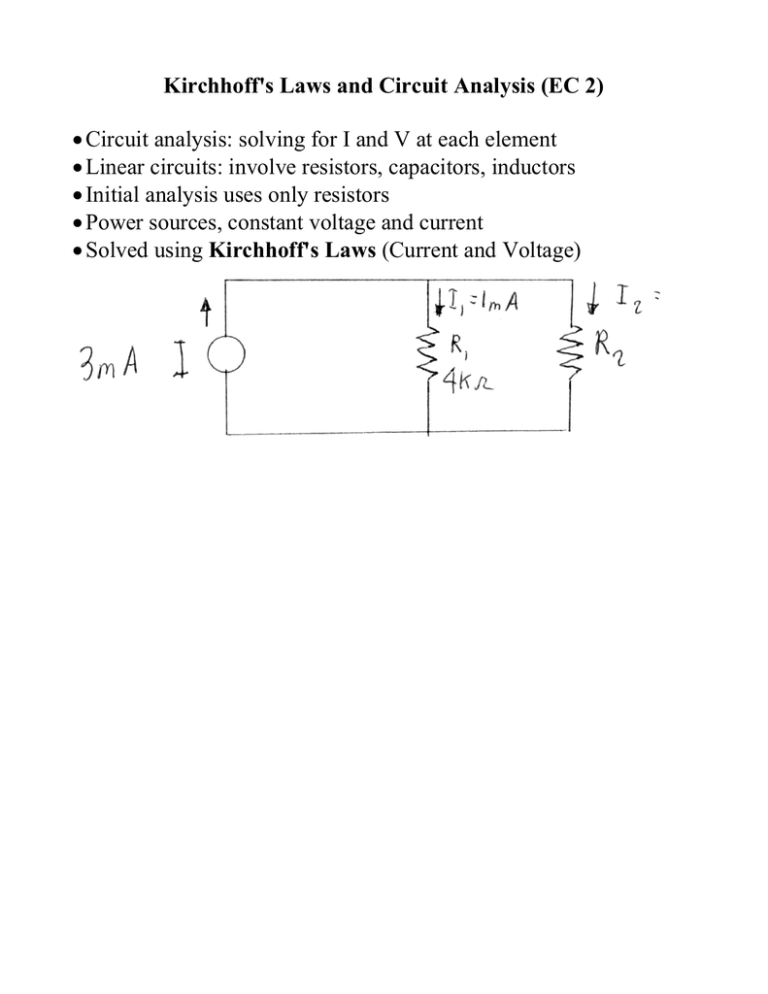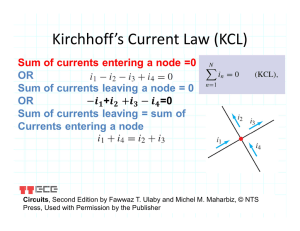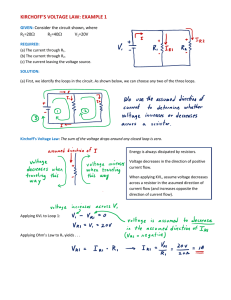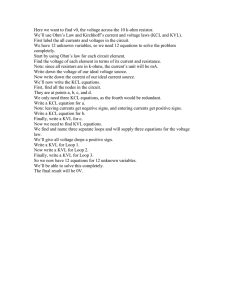Kirchhoff`s Laws and Circuit Analysis (EC 2) • Circuit analysis
advertisement

Kirchhoff's Laws and Circuit Analysis (EC 2) • Circuit analysis: solving for I and V at each element • Linear circuits: involve resistors, capacitors, inductors • Initial analysis uses only resistors • Power sources, constant voltage and current • Solved using Kirchhoff's Laws (Current and Voltage) Circuit Nodes and Loops • Node: a point where several wires electrically connect • Symbolized by a dot or circle at the wire crossing • If wires cross without dot, then not connected • Nodes also called junctions • Typically give notes a number or letter • Branches: lines with devices connecting two nodes • Loop: an independent closed path in a circuit • There may be several possible closed paths Kirchhoff's Current Law (KCL) • Kirchhoff's Current Law (KCL) • The algebraic sum of currents entering any node (junction) is zero. N ∑Ij = 0 j =1 where N = number of lines entering the node • NOTE: the sign convention, • Currents are positive when they entering the node • Currents negative when leaving • Or the reverse of this. KCL is called a continuity equation: It says current is not created or destroyed at any node. Example of Kirchhoff's Current Law (KCL) • Consider the simple parallel resistances below • At node 1 define current positive into resistors • Since V on R1 = 6V the current is I1 = 5 V = = 5 mA R1 1000 • Same V on R2 = 6V the current is I1 = 5 V = = 1 mA R2 5000 • Thus by KCL at node 1 I1 + I 2 + I 3 = 0.005 + 0.001 + I 3 = 0 • Thus the total current is I 3 = − I1 − I 2 = −6 mA • Node 2 has the negatives of these values Kirchhoff's Voltage Law (KVL) • Kirchhoff's Voltage Law (KVL) • Algebraic sum of the voltage drops around any loop or circuit = 0 N ∑V j = 0 j =1 where N = number of voltage drops • NOTE: the sign convention • Voltage drops are positive in the direction of the set loop current. • Voltage drops negative when opposite loop current. • Voltage sources positive if current flows out of + side • Voltage sources negative if current flows into + side • A loop is an independent closed path in the circuit. • Define a "loop current" along that path • Real currents may be made up of several loop currents I R1 = I1 − I 2 Example Kirchhoff's Voltage Law (KVL) Consider a simple one loop circuit Voltages are number by the element name eg. V1 or VR1 : voltage across R1 Going around loop 1 in the loop direction Recall by the rules: • Voltage drops negative when opposite loop current. • Voltage sources positive if current flows out of + side V s− V1 = 0 Example Kirchhoff's Voltage Law (KVL) Continued • Thus voltage directions are easily defined here: V s− V1 = 0 • Why negative V1? Opposes current flow I1 • Since V1 = I1 R1 V s− I1R1 = 0 • Thus this reduces to the Ohms law expression I1 = Vs R1 KVL Example Resistor Voltage Divider • Consider a series of resistors and a voltage source • Then using KVL V − V1 − V2 = 0 • Since by Ohm’s law V1 = I1R1 V2 = I1R2 • Then V − I1R1 − I1R2 = V − I1 ( R1 + R2 ) = 0 • Thus I1 = 5 V = = 1 mA R1 + R2 2000 + 3000 • i.e. get the resistors in series formula Rtotal = R1 + R2 = 5 KΩ KVL Example Resistor Voltage Divider Continued • What is the voltage across each resistor • Now we can relate V1 and V2 to the applied V • With the substitution I1 = V R1 + R 2 • Thus V1 V1 = I1R1 = 5(2000) VR1 = = 2V R1 + R2 2000 + 3000 • Similarly for the V2 V1 = I1R2 = 5(3000) VR2 = = 3V R1 + R2 2000 + 3000 KVL and KCL for Different Circuits • With multiple voltage sources best to use KVL • Can write KVL equation for each loop • With multiple current sources best to use KCL • Can write KCL equations at each node. • In practice can solve whole circuit with either method Resistors in Series (EC3) • Resistors in series add to give the total resistance N Rtotal = ∑ R j j =1 • Example: total of 1, 2, and 3 Kohm resistors in series • Thus total is Rtotal = R1 + R2 + R3 = 1000 + 2000 + 3000 = 6 KΩ • Resistors in series law comes directly from KVL Resistors in Parallel • Resistors in parallel: • Inverse of the total equals the sum of the inverses 1 Rtotal N 1 j =1 R j =∑ This comes directly from KCL at the node I total N N V V = = ∑Ij = ∑ Rtotal j =1 j =1 R j • NOTE: inverse of resistance called conductance (G) • Unites are mhos (ohms spelled backwards) N Gtotal = ∑ G j j =1 • Thus when work in conductance change parallel to series Example Parallel Resistors Example 1K and 2K resistors in parallel 1 Rtotal N 1 1 1 3000 = + = 1000 2000 2000000 j =1 R j =∑ Rtotal = 666 Ω Example Parallel Resistors • Example: two 1 Kohm resistors in parallel 1 Rtotal N 1 1 1 2 = + = K or K Rtotal = 500 Ω 1000 1000 1000 j =1 R j =∑ • Thus adding N same resistors cuts get Rtotal = • Good way to get lower R values R N






